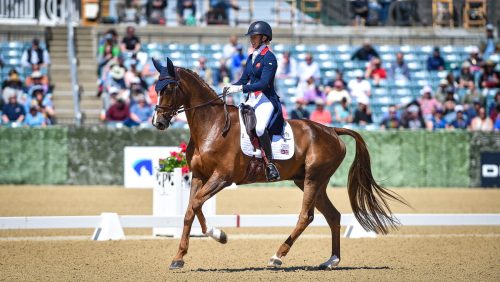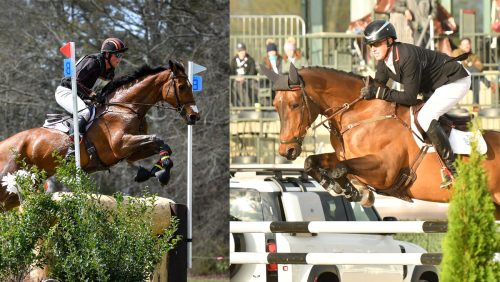Caledon, Ontario – July 16
The cross-country course at the Pan American Games officially opened today and we took a walk with former Canadian Chef D’Equipe Graeme Thom to learn about some of the key combinations. Along the way, we also stopped to chat with course builder Eric Bull, who’s created some absolutely beautiful fences that will leave a legacy for Will O’Wind Farm, or the Pan Am Cross-Country Centre as it’s known for the duration of the Games.

Riders will start over Fence 1, where they’re greeted by the Pan Am mascot Pachi! Photo by Lindsay Berreth.
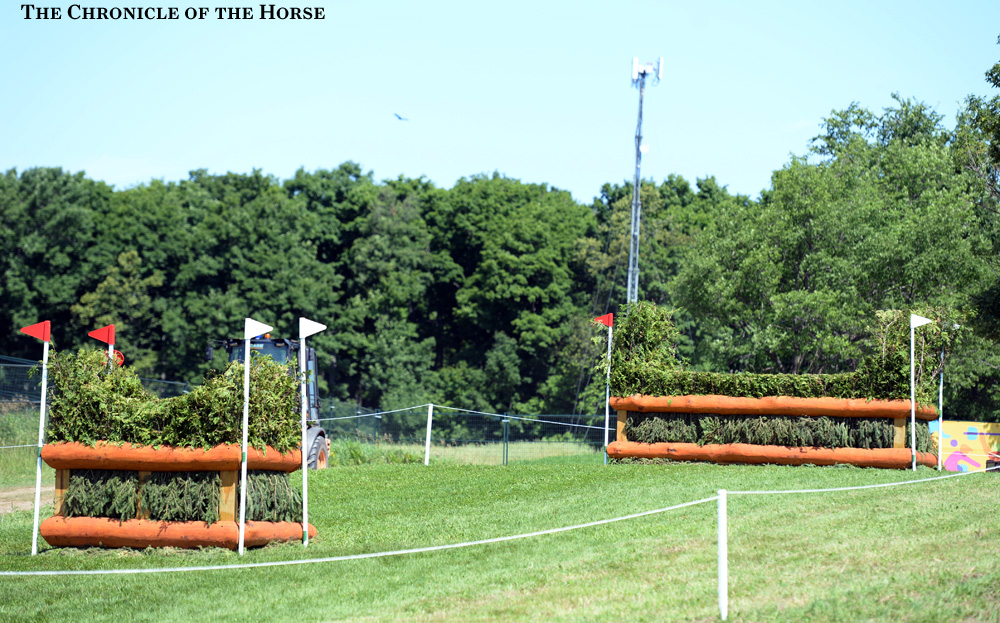
The first combination comes at 3 and 4, a straightforward four-stride line down a slight hill over a big brush and a narrower brush. Photo by Lindsay Berreth.
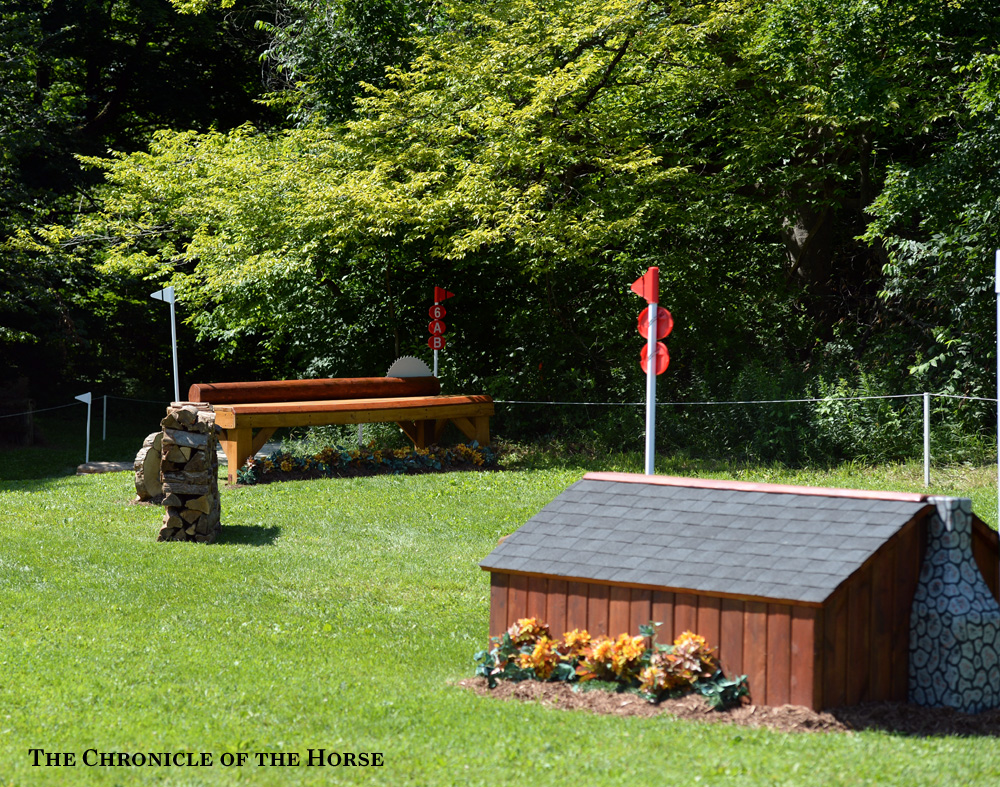
The first real question comes at 6ab, a table in the shade at the edge of the woods to a log. Photo by Lindsay Berreth.
“The course is designed with the first three or four jumps to get the horses going in a rhythm,” said Thom. “There’s some double hedges [3 and 4] that are in an absolute dead straight line. The direct route over the table [6a] takes them to where the ground falls away to a narrow [6b.] In this situation, if you take the direct route, your horse is only jumping two efforts. The long route [a cabin to a log to the B element log of the straight route] he’s jumping three.”
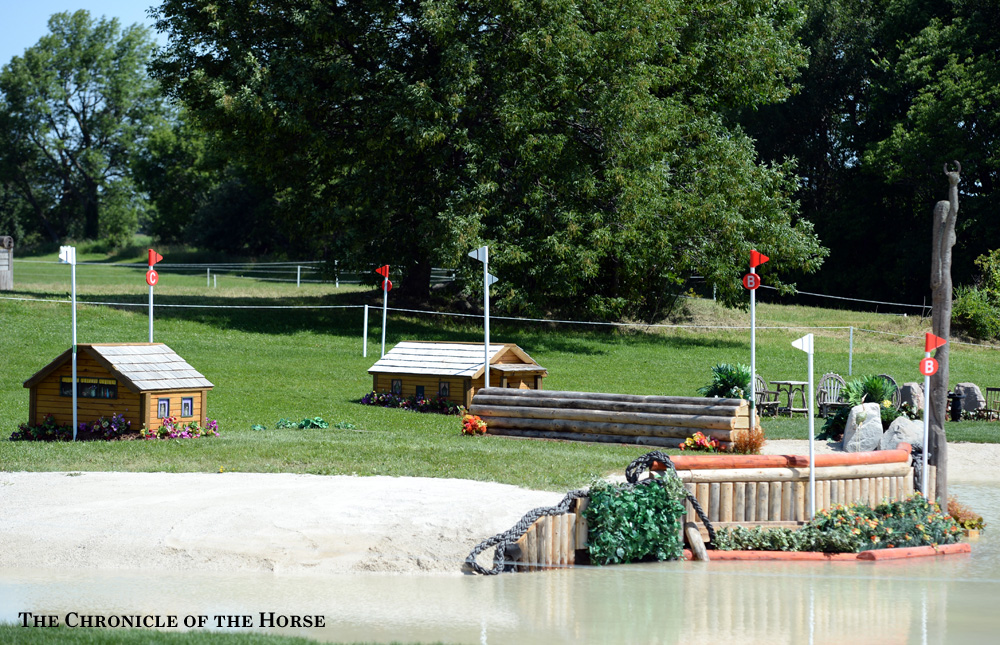
ADVERTISEMENT
After jumping a keyhole, riders are faced with the next big question, fence 12abc, a brush on top of a mound to the first water. Here’s B and C. Photo by Lindsay Berreth.
“The direct route comes from the keyhole, up over the mound, then basically it’s not a related distance,” said Thom. “People will try to make it one but it shouldn’t be. They’ll jump over the hedge over the top [12a.] It’s still early on in the course, so horses will pull the rider right down to the base of that. When they hit the [edge of the] water, it’s roughly two strides, pop up on the bank [12b,] one stride out over the hut [12c] and then straight.”
The option is a hedge on the side of the mound, turn left then loop right to a cabin on the island in the water, then turn left to a cabin on the grass, which will eat up time.
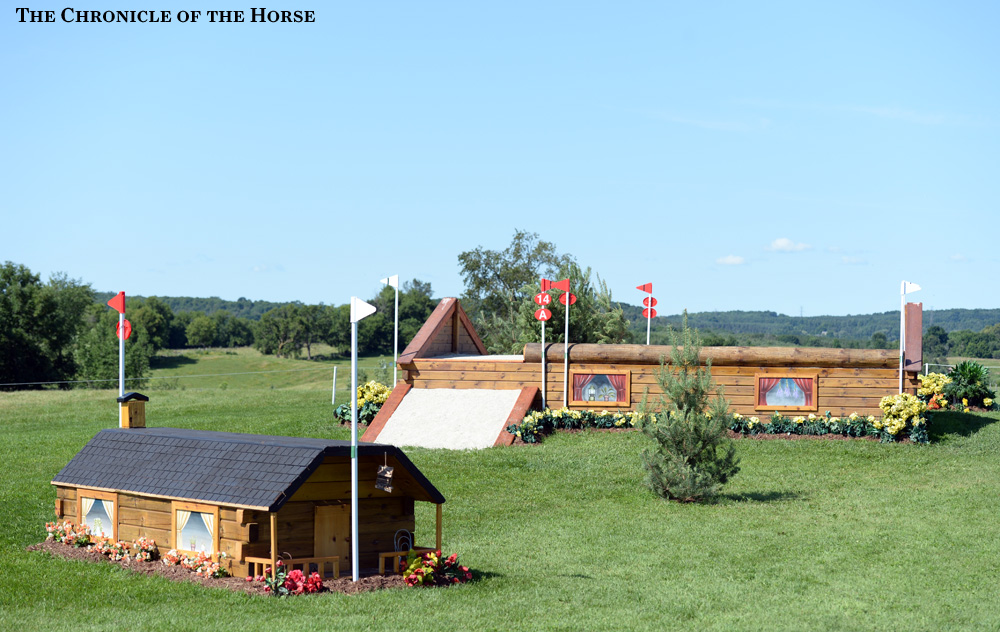
The backside of 14ab. Photo by Lindsay Berreth.
The brand new bank complex at 14ab seems simple enough, but a huge ditch on take-off over the bank at the A element could catch out some spooky horses or timid riders. They have the option of trotting back up a ramp onto the bank, turning around on top and jumping off. It’s best to go inside the little tree to get the distance and avoid a runout at the B element.
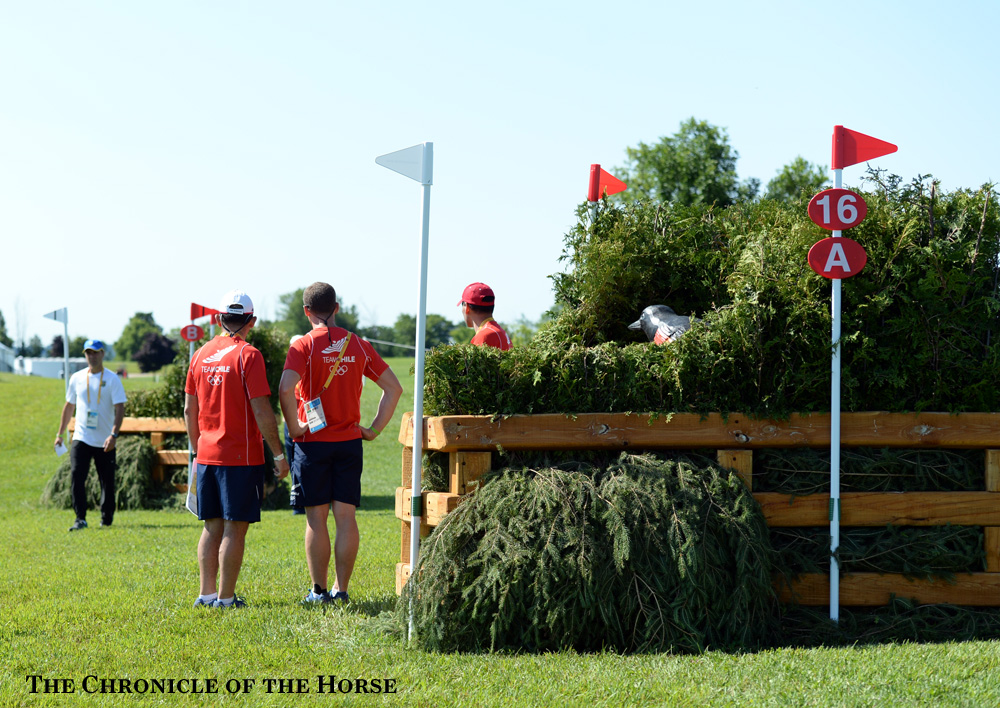
Fence 16ab, a set of left-handed corners, could cause a glance off, but there’s also a long option for those who want to play it safe. Photo by Lindsay Berreth.
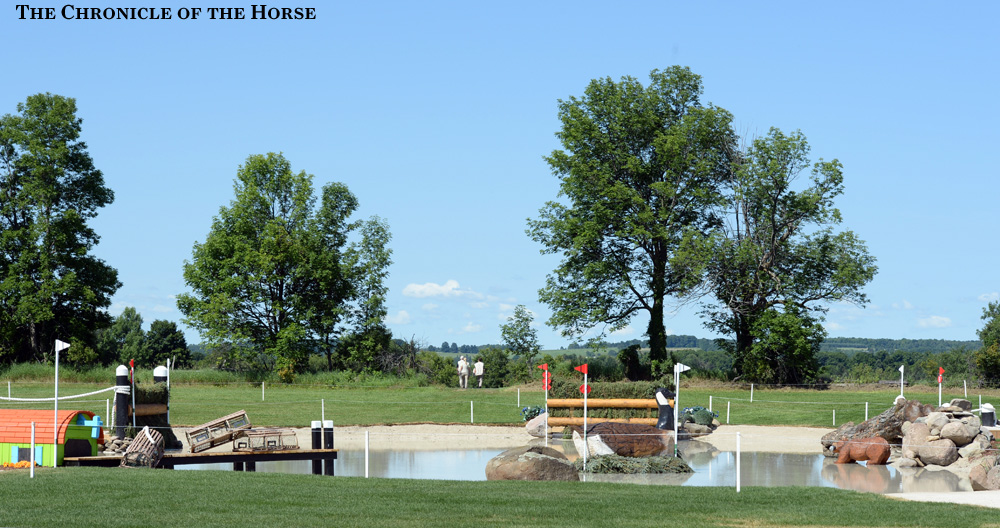
The feature fence, the main water 20abc, will require a bold jump in over the hedge and accuracy over the Canadian goose in the water and out over the narrow log. Photo by Lindsay Berreth.
ADVERTISEMENT
“On landing that’s 1.80 meters, which is maximum for a two-star,” said Thom. “This will be an influential fence. They then gallop over the goose and out over the log at the end—that’s the direct route. If somebody wants to take the alternate route, they swing out to the right, jump the other hedge, which is about 1.40-meter for the landing, roughly five strides across the water to the bank, swing right, over the roll top, then swing either inside if they’re gutsy, or outside the goose to head out. The long route takes a lot of extra time.”
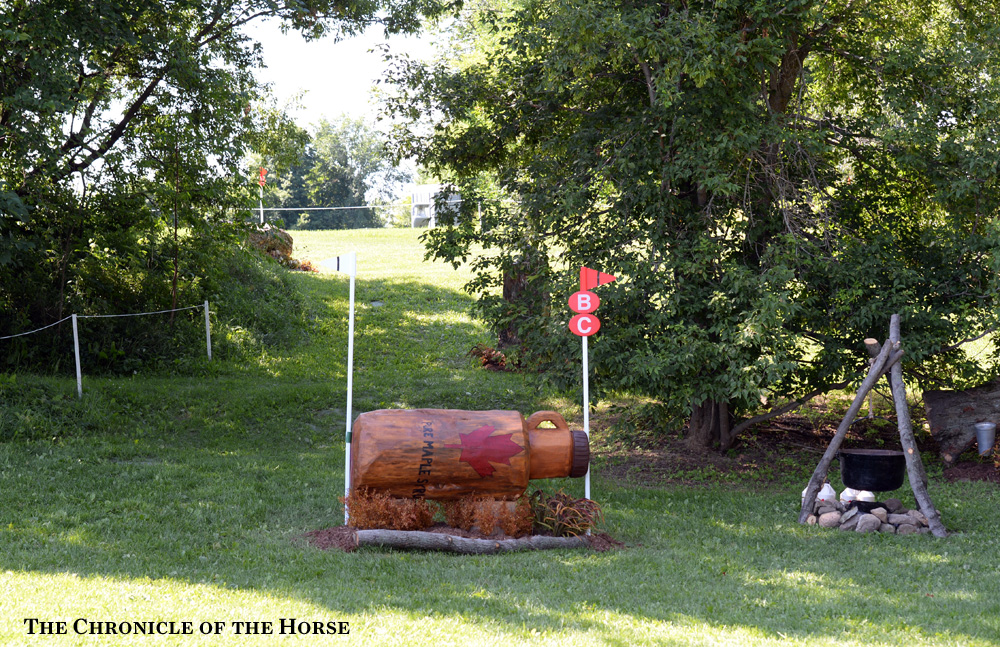
23b and 24. Photo by Lindsay Berreth.
The final big combination at 23 could catch out tired combinations. The drop isn’t that big, but the sharp turn to the right over a narrow maple syrup bottle is acute. Then they head up a hill and jump 24, a log, on a bit of an angle coming out of the wooded path.
“It’s about four strides to the maple syrup hut, then you jump the log on top of the hill at an angle,” said Thom “This will be one of the more influential fences. The people that go the direct route are the people that are trying to be competitive. The long route is for people to jump off the bank, circle up the hill, come back down over a log and then turn left to the C element [another log] on the right side of the maple syrup.”
Bull, who’s built at big events like Fair Hill (Md.) and Plantation Field (Pa.), shipped all of the new portables from the U.S. and said building for this event is unlike anything he’s ever done because of all the layers of people and rules he had to go through, but he’s excited to see how the event plays out.
“I think [course designer Wayne Copping] did a good, balanced cross-country course,” he said. “I don’t think there’s any particular jump that’s not a fair two-star question, but because it’s an international Games, you’re going to have a weaker field than you would at a Fair Hill. I think what you’re going to see is the largest attrition early on. I think you’ll see attrition at the brushes [3 and 4] and [at 6ab,] not because the fences are unbalanced or unfair or terribly difficult, but because you’re going to have some number of people who showed up unprepared to get around an international two-star.”
The terrain is rolling with a few fences in or near the woods and the optimum time is 8 minutes 39 seconds. “It’s rolling, so overall, you’re going to be climbing and dropping and climbing and dropping,” he said. “You’re going to do a lot of climbing before you get to the 8-minute mark, but that said, the hills are short, which is easier than climbing long hills.”
Thom added that a steady pace will be necessary. “It’s an old expression I was taught years ago when I was riding and it’s, ‘Don’t shake the Volkswagon,’ meaning that when the horses come out, if they come out hell bent for leather, running 650 meters between the jumps, they’re going to run out of gas,” he said. “There’s enough of a terrain here that it’s going to reward the people with experience that keep control, get their horses rated properly and just go for the time—not be way ahead of their early minute markers.”
Want more photos? Click the photo in the left corner above or here!







